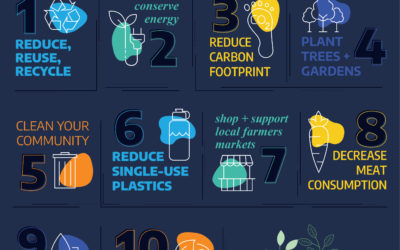Global Recycling Day 2020: Why Reusing Construction Debris is Critical
Global Recycling Day 2020: Why Reusing Construction Debris is Critical

Recycling is a Pillar of the Circular Economy
Global Recycling Day 2020 is an appropriate time to take stock of recycling efforts. Unfortunately, the vast majority of the world’s natural resources are used only once and then discarded. At some point in the near future, these resources will run out, and what do we do then?
A key component to avoiding that stark scenario is to increase recycling efforts. Instead of looking at discarded materials as waste, they can be seen as an opportunity. Recycling is part of the “circular economy,” which seeks to reduce waste by reusing materials as much as possible.
Furthermore, recycling – also called the “Seventh Resource” – saves over 700 million tons annually in carbon (CO2) emissions. This is projected to increase to one billion tons by 2030. As such, recycling can play a vital role in helping us to save the environment, not to mention humanity.[1]
Recycling is a key component of the Circular Economy.
Construction Debris Is a Real Problem
One of the primary waste offenders is the construction industry. Annually, over 35 billion tons of non-metallic minerals are extracted every year, the vast majority of which goes toward construction. In the process, since recycling is limited, huge quantities of construction and demolition (C&D) debris is generated. In fact, it makes up 35% of the world’s landfills.[2]
How can construction generate so much waste? The problem is older buildings are demolished and almost nothing is recycled. C&D debris consists of many materials, including concrete, steel, wood, drywall and plaster, brick and clay tile, asphalt shingles and more.[3]
C&D debris composition by material before processing, 2017. Total equals 569 million tons. (Source: EPA)
Exponential Increase of Construction Debris
Thus, it’s clear the construction industry’s waste can add up, but what do the numbers look like?
Well, in the U.S. in 2017 alone, 569 million tons of C&D debris were generated. This is more than twice the amount of municipal solid waste. Out of the C&D debris total, demolition represents more than 90%, while construction is less than 10%.[4]
To make matters worse, the amount of C&D debris in the U.S. is going up exponentially.[5] The chart here shows this increase in the U.S.
Construction and demolition debris by weight in thousands of tons. (Source: EPA)
Building Materials Can Be Reused
If previously used construction materials are to be recycled, how can they be reused? Today, there are many uses for C&D debris, such as:[6]
- Scrap metals can be recycled almost endlessly
- Asphalt can be crushed and reconstituted
- Clean and untreated wood can be turned into lumber and chipboard
- Both gypsum, used to build walls, and glass from windows and tiles, can be refashioned into many new products
The Benefits of Reusing Construction Debris
Recycling building materials is a simple and impactful way to support sustainability. Minimizing resource depletion will significantly reduce greenhouse gas (GHG) emissions and safeguard the environment.
In addition, reusing construction debris will help to establish a circular economy by replacing production with sufficiency. In this scenario, businesses will be protected against a shortage of resources and unstable prices.[7]
Specifically, recycling C&D debris will lead to the following results:
- Reduced energy use: When C&D debris is recycled, fewer natural resources are extracted, which cuts down on energy consumption. For instance, recycling the concrete and asphalt waste generated annually in the U.S. would save the energy equivalent of one billion gallons of gasoline.[8]
- Minimized landfill waste: It’s imperative that alternative ways to manage waste are developed since landfills are filling up. Recycled construction waste can be reused as it is or converted into other materials.[9]
- Decreased costs: Reusing construction materials cuts the cost of disposal and transportation. Moreover, recycling reduces the demand for new resources, which cuts transportation and production costs.[10]
- Realized green certifications: Many green-building certifications require reusing used building materials during the construction process. By recycling C&D debris, building owners can achieve high-level certifications for building sustainability.[11]
In Summary
The high levels of debris generated annually by the construction industry represents a serious challenge to sustainability. However, it doesn’t have to be this way. Reusing this waste reduces carbon emissions, supports the environment and leads to new business opportunities. Therefore, recycling construction and demolition debris is critical on Global Recycling Day and every day.
[1] “ABOUT GLOBAL RECYCLING DAY,” Global Recycling Day, https://www.globalrecyclingday.com/.
[2] Seyed Ghaffar, “How we can recycle more buildings,” The Conversation, December 4, 2019, https://theconversation.com/how-we-can-recycle-more-buildings-126563.
[3] “Construction and Demolition: Material-Specific Data,” U.S. Environmental Protection Agency (EPA), https://www.epa.gov/facts-and-figures-about-materials-waste-and-recycling/construction-and-demolition-material-specific.
[4] “Sustainable Management of Construction and Demolition Materials,” U.S. Environmental Protection Agency (EPA), https://www.epa.gov/smm/sustainable-management-construction-and-demolition-materials.
[5] “Construction and Demolition: Material-Specific Data,” U.S. Environmental Protection Agency (EPA), https://www.epa.gov/facts-and-figures-about-materials-waste-and-recycling/construction-and-demolition-material-specific.
[6] All subsequent bullets sourced from: Margherita Sforza, “Recycled construction waste: building a more sustainable future,” Construction21, https://www.construction21.org/articles/h/recycled-construction-waste-building-a-more-sustainable-future.html.
[7] Seyed Ghaffar, “How we can recycle more buildings,” The Conversation, December 4, 2019, https://theconversation.com/how-we-can-recycle-more-buildings-126563.
[8] Chelsey Bipat, “Recycling Construction Materials,” NY Engineers, https://www.ny-engineers.com/blog/recycling-construction-materials.
[9] Chelsey Bipat, “Recycling Construction Materials,” NY Engineers, https://www.ny-engineers.com/blog/recycling-construction-materials.
[10] Chelsey Bipat, “Recycling Construction Materials,” NY Engineers, https://www.ny-engineers.com/blog/recycling-construction-materials.
[11] Chelsey Bipat, “Recycling Construction Materials,” NY Engineers, https://www.ny-engineers.com/blog/recycling-construction-materials.
Insights
Earth Day 2024
Earth Day— the HIGHMARK Way It’s April 22, a day that marks the 54th anniversary of the modern-day environmental movement—otherwise known as Earth Day. This holiday comes and goes each year and many...
World Water Day 2023: Accelerating Change via Building Efficiency
World Water Day 2023: Accelerating Change via Building EfficiencyFocus of World Water Day 2023: Accelerating Change Celebrated annually on March 22, World Water Day's theme this year is...
LL97 Proposed Rules & the Building-Efficiency Technologies To Achieve Them
LL97 Proposed Rules & the Building-Efficiency Technologies To Achieve ThemHere's what you need to know about Local Law 97's proposed rules (thanks to Urban Green Council), and the...
Technologies
Resources
About Us
© 2023 HIGHMARK | Building Efficiency






